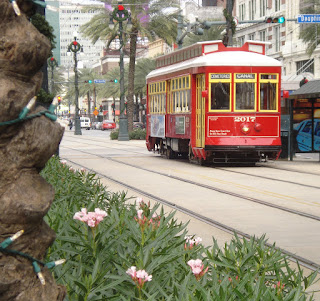I confess until recently, I didn’t know much about Mardi Gras—only that it involved parades, beads, and a reputation for debauched behavior. Even though many cities worldwide celebrate Mardi Gras (which takes place tomorrow), New
In New Orleans New Orleans
Historically, masks were worn to many of the balls, and eventually it became traditional to wear a mask on the street on Mardi Gras day. However, in the early 19th century, people behaved so outrageously while hidden behind masks that they were forbidden for decades!
Even though (or perhaps because?) this festival has roots in pagan celebrations, Pope Gregory XIII made Mardi Gras a Christian holiday in 1582 when he placed it on the calendar on the day before Ash Wednesday.
The first North American Mardi Gras took place when two French explorers and brothers, Pierre Le Moyne, Sieur d’Iberville and Jean-Baptiste Le Moyne, Sieur de Bienville, found the mouth of the Mississippi on Mardi Gras day (March 3) 1699. They made camp, named the spot Point du Mardi Gras, and celebrated. Bienville later went on to found New Orleans
King cakes begin to be sold on Jan. 6 (also known as King’s Day). The brightly colored cakes have a small plastic baby baked inside them. According to tradition, whoever gets the baby in his or her piece has to buy the next cake.
On Mardi Gras day, there are parades all day long. Sometimes as many as two million people flood the streets of New Orleans
 |
| King cake--Photo courtesy Wikimedia Commons |
Revelers line the parade routes hoping for “throws”—beads, doubloons, cups and other souvenirs. According to several New Orleans
The Rex organization, which debuted in 1872, is responsible for the official Mardi Gras colors (purple, green and gold), for starting daytime parades, and for the anthem of Carnival, “If I Ever Cease to Love.” Every year, the organization chooses an outstanding civic leader to reign over Mardi Gras, and this person is known as Rex, King of Carnival. Rex arrives by boat on the Monday before Mardi Gras, and is conveyed to City Hall in a carriage where he accepts the keys to the city from city leaders. On Mardi Gras day, he rides his float through the streets of his kingdom.
Do you celebrate Mardi Gras?
Want to know more? Check out Mardi Gras New Orleans or New Orleans Online.
 |
| Laissez les bon temps rouler! (“Let the good times roll!”) |
Want to know more? Check out Mardi Gras New Orleans or New Orleans Online.




























.jpg)


